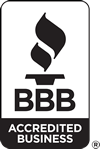You count on your generator in times of crisis. But what happens when your generator lets you down?
Even when the product or service is the same, differences in the number of customers and employees, hours of operation, and surrounding environment affect the amount of power used. It’s important to do your own estimate. But the best way to ensure you get the right size commercial generator is to consult a commercial generator installation service.
Why your Business needs a Backup Generator
Backup power for heating, refrigeration, freezer units, computers, and other technology and even security is crucial during a power outage, especially extended outages. Without a backup generator, most businesses would be forced to close. This could be financially devastating during peak hours or when a major deadline is due.
Commercial generators can prevent the types of losses associated with prolonged outages. But only if the generator is properly sized for the needs of the business. Having too little power in times of emergency is just as frustrating as having none at all.
Calculating the Correct Size Commercial Generator
Selecting the correct commercial generator is more involved than choosing one for a home. In most cases, a greater surge capability and bigger reserve are needed. This is especially true when large or multiple pieces of independently operating equipment are involved. Fortunately, sizing is a fairly straightforward process. There are two basic methods used, Full Load Capacity and Square Footage.
To correctly use either of the following methods, remember that one kilowatt equals 1000 watts.
Method 1, Full Load Capacity
To calculate the right size of commercial generator with this method, grab your calculator and follow these steps:
- Take full-load current measurements during a time of peak usage. At the service panel, apply a clamp-on ammeter to each arm of the electrical service. Add the two measurements together. This number is the total amps used.
- Divide the total amps by two for a single-phase current or by three for a three-phase current. Multiply that number by the supply voltage. Then multiply that number by 1000. The total is the kilowatts required.
- Consult the National Electrical Code website to learn the kilowatts needed to operate each emergency safety system in your commercial residence. Reference articles 700 through 702 and article 708 to learn the numbers required for Full Load Kilowatts.
- Multiply the Full Load Capacity by .25 to compute Reserve Capacity. Use the equation Total amps x Supply Voltage/1000 = Full Load Kilowatts.
- Add the Full Load Capacity and Reserve Capacity. This number represents the generator size needed to provide 100 percent backup power.
Method 2, Square Footage
This the easiest method for most retail stores or restaurants. It requires only two steps:
- For retail applications, estimate 50 kilowatts plus 10 additional watts for every square foot of space.
- For commercial application, estimate 50 kilowatts plus 5 additional watts per square foot.
Call a Commercial Generator Installation Service
If you're still uncertain what size backup generator your commercial building requires. call the pros at Virginia Power Solutions. Our friendly team of pros can advise you on every step, including sizing, installation, maintenance, and repair. With our team in your corner, your business may never miss a day or a dollar because of power outages.



